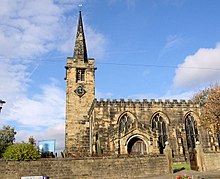Church in Worsbrough, England
| Church of St Mary, Worsbrough | |
|---|---|
 | |
| 53°31′09″N 1°28′27″W / 53.519164°N 1.474104°W / 53.519164; -1.474104 | |
| OS grid reference | SE 34967 02622 |
| Location | Worsbrough |
| Country | England |
| Denomination | Church of England |
| Churchmanship | Broad church |
| Website | acny |
| Administration | |
| Province | York |
| Diocese | Diocese of Sheffield |
| Archdeaconry | Doncaster |
| Deanery | Tankersley |
| Parish | Worsbrough |
The Church of St. Mary is the parish church in the village of Worsbrough in South Yorkshire, England. It is a Church of England church in the Diocese of Sheffield. The building is Grade I listed and was built in the 12th century, however evidence of Saxon stonework suggests an older building on this site. Parts of the chancel are early Norman but the church underwent several alterations in the 14th and 15th century including the installing of the south door with its Gothic inscription which dates to 1480.
Seventy five miners who were killed in the 1849 Darley Main Colliery disaster lay buried in the churchyard in a mass grave.
See also
References
- Ashurst, Denis (1997). The Church and Parish of St. Mary, Worsbrough. D. Ashurst.
- "Conservation Areas: Site CA17 Worsbrough". Barnsley Council. Archived from the original on 3 September 2012. Retrieved 16 May 2015.
- ^ "Worsbrough St. Mary". Heritage Inspired. Archived from the original on 18 October 2016. Retrieved 17 October 2016.
- Historic England. "CHURCH OF ST MARY (1315083)". National Heritage List for England. Retrieved 17 October 2016.
- "Dreadful Explosion At The Darley Main Colliery, Near Barnsley". Newcastle Guardian and Tyne Mercury. 3 February 1849. p. 3. Retrieved 16 May 2015.
External links
| Churches in the Deanery of Tankersley | |
|---|---|
| Benefice of Hoyland |
|
| Benefice of Penistone and Thurlstone |
|
| Benefice of Tankersley |
|
| Benefice of Worsbrough with Elsecar |
|
| Benefice of Worsbrough Common |
|
This article about a Yorkshire building or structure is a stub. You can help Misplaced Pages by expanding it. |
This article about a church or other Christian place of worship in England is a stub. You can help Misplaced Pages by expanding it. |